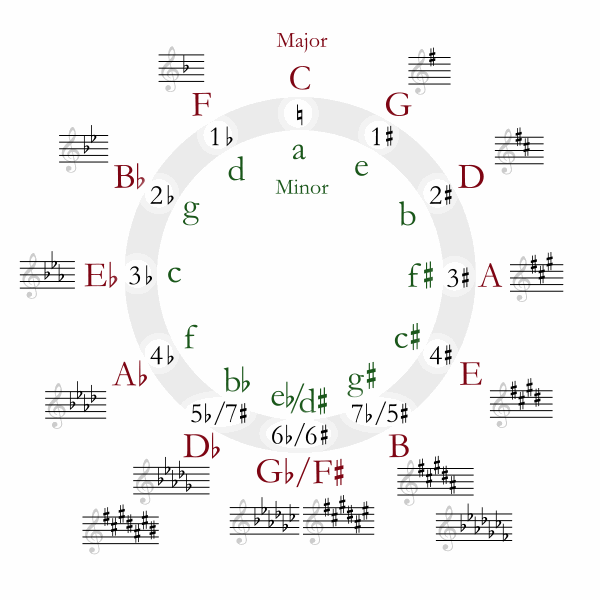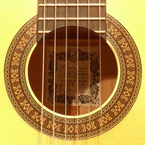Welcome to one of the most active flamenco sites on the Internet. Guests can read most posts but if you want to participate click here to register.
This site is dedicated to the memory of Paco de Lucía, Ron Mitchell, Guy Williams, Linda Elvira, Philip John Lee, Craig Eros, Ben Woods, David Serva and Tom Blackshear who went ahead of us.
We receive 12,200 visitors a month from 200 countries and 1.7 million page impressions a year. To advertise on this site please contact us.
|

|
|
[Deleted]
|
You are logged in as Guest
|
|
Users viewing this topic: none
|
|
Login  | |
|

   
JasonMcGuire
Posts: 1141
Joined: Apr. 10 2007

|
 RE: HELP - E Phrygian Question (Clau... (in reply to Guest) RE: HELP - E Phrygian Question (Clau... (in reply to Guest)
|
|
|
No sharps or flats means they are all E phrygian. The same group of notes a C major (aka C Ionian). The Greek modes are 7 different names for the same group of 7 notes. Here C major is the group. You can simplify you life by just accepting that C Ionian, D Dorian, E Phrygian, F Lydian, G Mixolydian, A Aeolian and B Locrian are all just names that describe no sharps or flats.
Add one sharp (f#)and you have they key of G major. G Ionian, A Dorian, B Phrygian, C Lydian, D Mixolydian, E Aeolian, F# Locrian.
Add 2 sharps (f#,c#) and you have the key of D major. D Ionian, E Dorian, F# Phrygian, G Lydian, A Mixolydian, B Aeolian, C# Locrian.
etc.

Images are resized automatically to a maximum width of 800px
 Attachment (1) Attachment (1)
_____________________________
http://www.Flamenco-Lessons.com/
http://www.CaminosFlamencos.com/
http://www.youtube.com/user/Bikhiyal
http://flamenco-lessons.blogspot.com
|
|
|
|
REPORT THIS POST AS INAPPROPRIATE |
Date Dec. 31 2008 15:02:40
 |
|

   
Ricardo
Posts: 14822
Joined: Dec. 14 2004
From: Washington DC

|
 RE: HELP - E Phrygian Question (Clau... (in reply to Guest) RE: HELP - E Phrygian Question (Clau... (in reply to Guest)
|
|
|
He means, and says in french I guess?, that if you were to stay in FIRST position and do those fingerings (really he means ZERO position starting from open strings), then you could do the same finger patterns and you would have a different key. Meaning move every pattern down to the open strings position, and your underlined note is your phrygian key tonic.
But he is showing different positions, in tab, literally for only one key, that being E phrygian, but same patterns work for other modes of the C scale. C major, A minor, G mix lydian etc. In other words, a very misleading way to show scales, but not inaccurate.
Ricardo
_____________________________
CD's and transcriptions available here:
www.ricardomarlow.com
|
|
|
|
REPORT THIS POST AS INAPPROPRIATE |
Date Dec. 31 2008 15:09:40
 |
|

   
Exitao
Posts: 907
Joined: Mar. 13 2006
From: Vancouver, Canada

|
 RE: HELP - E Phrygian Question (Clau... (in reply to Ricardo) RE: HELP - E Phrygian Question (Clau... (in reply to Ricardo)
|
|
|
quote:
ORIGINAL: Ricardo
He means, and says in french I guess?, that if you were to stay in FIRST position and do those fingerings (really he means ZERO position starting from open strings), then you could do the same finger patterns and you would have a different key. Meaning move every pattern down to the open strings position, and your underlined note is your phrygian key tonic.
But he is showing different positions, in tab, literally for only one key, that being E phrygian, but same patterns work for other modes of the C scale. C major, A minor, G mix lydian etc. In other words, a very misleading way to show scales, but not inaccurate.
Ricardo
Ricardo:
Basically, you're saying that by moving your fingering down to different frets (yet on the same strings), you're just doing the same scales, in a different key, but in the same mode?
_____________________________
Callidus et iracundus.
|
|
|
|
REPORT THIS POST AS INAPPROPRIATE |
Date Dec. 31 2008 17:20:20
 |
|

  
Anders Eliasson
Posts: 5780
Joined: Oct. 18 2006

|
 RE: HELP - E Phrygian Question (Clau... (in reply to Guest) RE: HELP - E Phrygian Question (Clau... (in reply to Guest)
|
|
|
Claude worms is way to mental IMHO. I have the books and I dont think much of them. Way to Brainy.
I would personally call example B for a G mixolydian and example C for an A Dorian, But I can see that he has put a little line under the E´s, so played with the E as the base tone, it would be a E phrygian scale.
I think Jason over simplified a bit, so I will just add. Theory says that if you play a scale without sharps or flats from C - C, its a Ionian scale (Also called C major)/ from D to D, Dorian scale. /From E - E its Phrygian./ F to F Lydian,/ G to G, mixolydian,/ A to A, Aeolian (also called a minor),/ B to B Locrian
This means in real life that when you play fandangos, you have the compás in E phrygian mode and the letra in Ionian (major) mode. Its the same notes. Just with the difference that the compás (and most falsetas) are with a feel that E is the base note (scale E to E) and that the letra is with the feel that C (Scale C to C) is the base note
Happy mental new year. 
_____________________________
Blog: http://news-from-the-workshop.blogspot.com/
|
|
|
|
REPORT THIS POST AS INAPPROPRIATE |
Date Jan. 1 2009 0:48:08
 |
|

   
Ricardo
Posts: 14822
Joined: Dec. 14 2004
From: Washington DC

|
 RE: HELP - E Phrygian Question (Clau... (in reply to Exitao) RE: HELP - E Phrygian Question (Clau... (in reply to Exitao)
|
|
|
quote:
ORIGINAL: Exitao
quote:
ORIGINAL: Ricardo
He means, and says in french I guess?, that if you were to stay in FIRST position and do those fingerings (really he means ZERO position starting from open strings), then you could do the same finger patterns and you would have a different key. Meaning move every pattern down to the open strings position, and your underlined note is your phrygian key tonic.
But he is showing different positions, in tab, literally for only one key, that being E phrygian, but same patterns work for other modes of the C scale. C major, A minor, G mix lydian etc. In other words, a very misleading way to show scales, but not inaccurate.
Ricardo
Ricardo:
Basically, you're saying that by moving your fingering down to different frets (yet on the same strings), you're just doing the same scales, in a different key, but in the same mode?
Pretty much yes. But it is redundant for you to say "same scale....same mode". Modes are scales.
Also notice guys this guy skipped a pattern. There could be one where you barre first fret and still have E phyrigian starting on F note. Also notice his diatonic pattern moves UP the neck, so if you were to transpose all to Zero fret position, you see how the tonic notes move DOWN by step. C#-B-A-G#-F#, and you could have E for the last one, which is the one he starts you with. But the one he skipped, is actually my favorite, LOL. IT would be D# phrygian with E bass. So like anders said, it would be your LYDIAN pattern based on the low note.
HE should have given this as example b), but in E phyrygian (as he was doing it) you have this, barre first fret:
E-------------------------------------------1-3-5--
B---------------------------------1-3-(5)-----------
G---------------------------2-4--------------------
D-----------------(2)-3-5--------------------------
3---------2-3-5-----------------------------------
E-1-3-5--------------------------------------------
And shifted back to ZERO fret you have your D# scale starting on E, ending on G#.
E-------------------------------------------0-2-4-
B---------------------------------0-2-(4)----------
G---------------------------1-3---------------------
D-----------------(1)-2-4--------------------------
A---------1-2-4------------------------------------
E-0-2-4---------------------------------------------
Since he meant for you to try each pattern at ZERO fret (open E), you notice the tonic notes move down the steps of the E scale, while actually changing key though since each step becomes "phrygian".
Ricardo
_____________________________
CD's and transcriptions available here:
www.ricardomarlow.com
|
|
|
|
REPORT THIS POST AS INAPPROPRIATE |
Date Jan. 1 2009 9:25:37
 |
|

   
JasonMcGuire
Posts: 1141
Joined: Apr. 10 2007

|
 RE: HELP - E Phrygian Question (Clau... (in reply to Ricardo) RE: HELP - E Phrygian Question (Clau... (in reply to Ricardo)
|
|
|
Anders,
You are right about the C to C and D to D thing, but who crates melodies that way? If you know that C major is E prhygian and you know how to play c major scales everywhere on the guitar, then you are good to go. Music is hard, simplify when possible. If it works for you to have 7 different names for the same thing then go for it.
I learned all that to pass tests at school, but the whole time I was laughing to myself at how it was over complicating things.
Ricardo,
Right on bro. You always explain things well. I am sure you are a fantastic teacher.
Happy New Year to you and all you guys here at the foro.
Guitarists should be able to place your index finger on every note of C major on the 6th string( open,1,3,5,7,8,10) and create a 3 note per string scale from that point. Then all the other keys,D,G,A etc. Then do the same with melodic minor and every other scale you can get a hold of.
I think Claude Worms is offering what he uses personally. I didn't read the text, but I doubt he intends it to be a complete study of the E Phrygian Scale on guitar.
_____________________________
http://www.Flamenco-Lessons.com/
http://www.CaminosFlamencos.com/
http://www.youtube.com/user/Bikhiyal
http://flamenco-lessons.blogspot.com
|
|
|
|
REPORT THIS POST AS INAPPROPRIATE |
Date Jan. 1 2009 9:50:00
 |
|

   
guitarbuddha
Posts: 2970
Joined: Jan. 4 2007

|
 RE: HELP - E Phrygian Question (Clau... (in reply to Guest) RE: HELP - E Phrygian Question (Clau... (in reply to Guest)
|
|
|
Hey Neal. Sorry to jump in at this late hour.
On the Worms books, I love them warts and all.
Open position in all keys is really hard to memorise but I am sure you will get there.
There is a tip which I can offer though for learning scales which I discovered way back in my electric guitar days. I will try and explain it breifly but forgive me if it goes on or isn't clear. (NOTE everything below applies to ascending scales but you can easily reverse it for descending )
For three notes per string major scales (and all modes derived from them) there are only three patterns.
A) First finger, whole tone whole tone. ( 1-stretch-2,4 or 1,3-stretch-4)
B) First finger, half tone whole tone. ( 1,2,4)
C) First finger,whole tone half tone. (1,3,4)
Now the way these follow each other on the neck is like this. Most of the time just go to the next string up. Except when moving from; (i) g to b string (ii) pattern A to pattern B ; in these instances you have to move up a fret with the first finger.
Now the really handy thing is that the patterns always go in the same order three of A then two of B and two of C then back to the start always and forever.
If you start on the first A pattern (thats A above not the A note) you get Mixolydian mode (if the first note is what you are thinking of as the tonic)
Second A gives you major/ionian mode.
Second B gives you phrygian.
You can go on for all of the modes or not worry about modes at all and just learn the sounds of the patterns.
Now this doesn't replace and isn't meant to replace any of the other advice prevciously offered, and unfortunately it doesnt cover minor scales or open strings. but if you have a little time (and if my explanation isn't too awful) then it might offer another perspective and one which (on the guitar if not in my words) is really really simple.
D.
|
|
|
|
REPORT THIS POST AS INAPPROPRIATE |
Date Jan. 2 2009 17:27:55
 |
|

   
Ricardo
Posts: 14822
Joined: Dec. 14 2004
From: Washington DC

|
 RE: HELP - E Phrygian Question (Clau... (in reply to mrMagenta) RE: HELP - E Phrygian Question (Clau... (in reply to mrMagenta)
|
|
|
quote:
ORIGINAL: mrMagenta
Sorry for my post-frenzy! Just thought i'd share a way to remember how the three note per string patterns link to each other.
If we just name the patterns like Guitarbuddha did, starting with AAABBC as A1 we get:
A1: AAABBC - Mixolydian
A2: AABBCC - Ionian (Major)
A3: ABBCCA - Lydian
B1: BBCCAA - Locrian
B2: BCCAAA - Phrygian
C1: CCAAAB - Aeolian (Minor)
C2: CAAABB - Dorian
To get them in the order: play the second patterns first: A2 C2 B2 then A3 inbetween, and then the first patterns in the same order A1 C1 B1
2 3 1
ACB A ACB
The thing i like with this way of looking at it is that you can start anywhere on the fretboard, whichever string and fret, and visualize the scale/mode you want to play from that note, over the whole fretboard from there.. man. i've been stuck in boxes.. that's why i'm so happy about this trick.
Cool, now do it for Rondeña.    Just kidding. Just kidding.
quote:
On a related note - this is a personal rant of mine so beware. I don't think it really is E phrygian anyway in flamenco - where does the E major chord come in then - there's no G sharp? I think it makes more sense to think of it as the notes of A melodic minor starting on E. A melodic minor is different on the way up and down like this
A B C D E F# G# A G F E D C B A
Here are all the notes found in a typical modal flamenco tune in the key of E
We have discussed this before. Spanish phrygian, used in flamenco, is a mix of natural phrygian (EFGABCD) and phrygian dominant (EFG#ABCD), with other notes of chromatic scale fair came, just like the relative major and minor keys can use (C major or Aminor). The modal concept is not so much based on a scale, but a harmonic environment, or atmosphere, set up by hearing the melodies above that E chord harmony.
The idea of melodic minor and flamenco is not really right because while you may use melodic minor in flamenco like the classical music does, the spanish phrygian scale is free to move up or down or however...no down up "rule" like in classical. The F#, if it were used so much, really kills the "mood" of E phrgian. Flamenco will also borrow from Parrallel major or minor keys. (a tune in E phrgian like solea, frequently borrows melodies from E major using B7 chord, and minor, and even mixolydian mode at times), and use simple chromatics.
Ricardo
_____________________________
CD's and transcriptions available here:
www.ricardomarlow.com
|
|
|
|
REPORT THIS POST AS INAPPROPRIATE |
Date Jan. 3 2009 15:06:13
 |
|

   
John O.
Posts: 1723
Joined: Dec. 16 2005
From: Seeheim-Jugenheim, Germany

|
 RE: HELP - E Phrygian Question (Clau... (in reply to JasonMcGuire) RE: HELP - E Phrygian Question (Clau... (in reply to JasonMcGuire)
|
|
|
quote:
No sharps or flats means they are all E phrygian. The same group of notes a C major (aka C Ionian). The Greek modes are 7 different names for the same group of 7 notes. Here C major is the group. You can simplify you life by just accepting that C Ionian, D Dorian, E Phrygian, F Lydian, G Mixolydian, A Aeolian and B Locrian are all just names that describe no sharps or flats.
Add one sharp (f#)and you have they key of G major. G Ionian, A Dorian, B Phrygian, C Lydian, D Mixolydian, E Aeolian, F# Locrian.
Add 2 sharps (f#,c#) and you have the key of D major. D Ionian, E Dorian, F# Phrygian, G Lydian, A Mixolydian, B Aeolian, C# Locrian.
Hey Jason, Ricardo an others,
the above is about where my knowledge of this theory stops. As a teen I remember memorizing these modes as a loop that closes at the 12th fret that you can spin how you want as long as you keep the order the same. What I'm missing is: how does the popular circle of 5ths help me besides for knowing which key sheet music is in? How does this connect to key changes within a piece or to understanding how a piece like "Cadencia" from Cañizares theoretically works? 7ths are clear to me (if maybe not completely), but there are 6ths, 9ths, 11ths, 13ths, augmented and diminished, and so on and so on.
True if one wants to just play traditional flamenco it's not necessary, but if one wants to create modern things like you guys do, what of the complex theory has helped you get there? There's a lot I got out through guesswork and learning pieces, I just have a problem with doing things I can't explain to myself or others, and I don't want to tell someone "well PDL, Tomatito and Chucuelo did it - that's why it works..."  On the other hand, I wonder how well the three could explain it themselves. On the other hand, I wonder how well the three could explain it themselves.
_____________________________
Don't sweat the petty things and don't pet the sweaty things
|
|
|
|
REPORT THIS POST AS INAPPROPRIATE |
Date Jan. 6 2009 3:39:51
 |
|

   
JasonMcGuire
Posts: 1141
Joined: Apr. 10 2007

|
 RE: HELP - E Phrygian Question (Clau... (in reply to John O.) RE: HELP - E Phrygian Question (Clau... (in reply to John O.)
|
|
|
quote:
ORIGINAL: John O.
7ths are clear to me (if maybe not completely), but there are 6ths, 9ths, 11ths, 13ths, augmented and diminished, and so on and so on.
If the 9ths,11ths and 13ths are not altered, then they are derived from the major scale.
If they are altered..... for example Bb7(#11)... then they are derived from the modes of th Melodic Minor or Harmonic Minor Scale. Bb7(#11) is the Chord built from the 4th tone in the F Melodic Minor Scale..... (F,G,Ab,Bb,C,D,E)....... stack 3rds together starting from the 4th degree Bb and you have Bb,D,F,Ab,C,E......
---1---
---1---
---0---
---1---
---1---
---0---
This is just ONE example. Stack 3rds from the other tones and see what chords you get. Do the same for Harmonic Minor. Do only one key to start and then do a second key....... the relationships will be the same only the note names change.
Learn the Intervals (relationships) and the note names aren't so important. This is how players like Wes Montgomery used very complex musical concepts without actually knowing theory. They learn by ear these intervallic relationships and use them with great accuracy even though they claim not to understand. They do on some level..... the most important level.....the music. Sitting around and talking about theory IS NOT music. Being able to explain theory is no guarantee that you will make great music. It can help though, even if you put it into your own terms. Scales are the building blocks of Harmony. Flamenco does not use ONLY major scales so learning more about what harmonies are created from these other scales will help open some doors.
Its not only modern flamenco that utilizes these concepts. Traditional flamenco is full of examples too. 
Here is a link that explains things more.....
http://www.jazz-music-makers.com/melodic-minor-scale.html
_____________________________
http://www.Flamenco-Lessons.com/
http://www.CaminosFlamencos.com/
http://www.youtube.com/user/Bikhiyal
http://flamenco-lessons.blogspot.com
|
|
|
|
REPORT THIS POST AS INAPPROPRIATE |
Date Jan. 6 2009 15:51:35
 |
|

   
Ricardo
Posts: 14822
Joined: Dec. 14 2004
From: Washington DC

|
 RE: HELP - E Phrygian Question (Clau... (in reply to John O.) RE: HELP - E Phrygian Question (Clau... (in reply to John O.)
|
|
|
quote:
ORIGINAL: John O.
quote:
No sharps or flats means they are all E phrygian. The same group of notes a C major (aka C Ionian). The Greek modes are 7 different names for the same group of 7 notes. Here C major is the group. You can simplify you life by just accepting that C Ionian, D Dorian, E Phrygian, F Lydian, G Mixolydian, A Aeolian and B Locrian are all just names that describe no sharps or flats.
Add one sharp (f#)and you have they key of G major. G Ionian, A Dorian, B Phrygian, C Lydian, D Mixolydian, E Aeolian, F# Locrian.
Add 2 sharps (f#,c#) and you have the key of D major. D Ionian, E Dorian, F# Phrygian, G Lydian, A Mixolydian, B Aeolian, C# Locrian.
Hey Jason, Ricardo an others,
the above is about where my knowledge of this theory stops. As a teen I remember memorizing these modes as a loop that closes at the 12th fret that you can spin how you want as long as you keep the order the same. What I'm missing is: how does the popular circle of 5ths help me besides for knowing which key sheet music is in? How does this connect to key changes within a piece or to understanding how a piece like "Cadencia" from Cañizares theoretically works? 7ths are clear to me (if maybe not completely), but there are 6ths, 9ths, 11ths, 13ths, augmented and diminished, and so on and so on.
True if one wants to just play traditional flamenco it's not necessary, but if one wants to create modern things like you guys do, what of the complex theory has helped you get there? There's a lot I got out through guesswork and learning pieces, I just have a problem with doing things I can't explain to myself or others, and I don't want to tell someone "well PDL, Tomatito and Chucuelo did it - that's why it works..."  On the other hand, I wonder how well the three could explain it themselves. On the other hand, I wonder how well the three could explain it themselves.
The circle of 5th shows relationships between key signature, scale or mode, and even harmony. Away to "use" the circle of 5ths is to think of chord progressions of songs. Look at the wheel jason posted above. Notice major keys outside, minor keys (lower case) inside. Imagine those were CHORDS. major chords outside, minor chords inside. So any group of 6 chords, outline a "key" or imply a scale/key signature as a group.
For example look at the group Eb,Bb,F,c,g,d. OK? If those were chords, you could relate melodies to all those chords using a scale with two flats. You could call the "key" Bb major if you wanted, but you could focus on a different chord as tonic and you some modal key perhaps. Either way, you can't escape the fact that using all 6 of those chords allows you to get away with having just 2 flats to relate everything.
Now if you wanted to change key, say by a 5th, well just look outside the group of 6 chords. A C major chord or Aminor chord, or simply removing a flat from your scale (specifcally the Eb would be removed), shifts your tonal center a notch around the wheel, clockwise. That is how you can change keys, by introducing a new chord or scale.
Thinking in reverse you can improvise over a set of chords, even just 2 chords, by understand how the chords relate. For example, a Gm chord and an Aminor chord could use just ONE scale if you wanted. As you can see as scale with ONE flat works for both. If you choose to play Gminor scale then A minor scale, you are deliberately ignoring the "relationship" the two chords have based on the circle of 5ths. And that maybe what you want. To go further you could pretend the G minor chord is from the scale with 3 flats, and A minor was from the scale that has one #. But the further you get away from relationg the chords close by as the wheel shows, the "weirder" or more far out your music will sound. The farthest or weirdest you can get form one key to another is straight across the wheel, the tritone. These concepts, when you experiment make you understand the "rules" or rather the reasons why keys and scales, chords, etc relate and sound "good" or "exotic" or whatever.
About modes. IN modal music, true modal music, you need a drone for reference. learning "modes" on western instruments is really pointless IMO unless you HEAR them and feel them over top of some static drone or harmony. D dorian means nothing to me as a scale. You have to hear NO SHARPS AND FLATS, specifically over top of a D note or Dminor chord. Any other chord move, kills the modality of it all. Starting or ending on any certain note is not enough for my ear. And you need not start or end on any specific note to hear and feel the "dorian" vibe, so long as you have that drone or chord. In jazz pop rock classical whatever music that is WESTERN, in order to mimic modal music without a drone, you can to a one or at most TWO chord Vamp. Any more than that as a harmony and you kill the vibe of the mode, whatever it is.
About extensions. As Jason said, stack 3rds to build a chord. After 7 notes you repeat note names in a scale, but if you stack 3rds you must go up to 13 to create all 7 notes. So a 13th chord, IS a mode! That is it. Any 13th chord gives you all the info you need musically to understand the key relation. So dorian is hearing a minor 13th chord. DFACEGB. So long as you keep the bass D, you hear dorian as a mode.
So if you have a naked chord, or just a minor7th chord, you can "colorize" it modally, wiht your own extensions. Hear Dm7. Play a Bb over that and you hear Aeoliean. Play B natural and you hear Dorian. Play Eb over that and you hear phrygian. ETC. So experiment with the circle of 5ths by making up chord progressions and relating different scales to those chords.
Ricardo
_____________________________
CD's and transcriptions available here:
www.ricardomarlow.com
|
|
|
|
REPORT THIS POST AS INAPPROPRIATE |
Date Jan. 7 2009 9:27:59
 |
|

   
Ricardo
Posts: 14822
Joined: Dec. 14 2004
From: Washington DC

|
 RE: HELP - E Phrygian Question (Clau... (in reply to Guest) RE: HELP - E Phrygian Question (Clau... (in reply to Guest)
|
|
|
One more thing about the modes and the circle of 5ths. A cool experiment is to use the low E string of the guitar like a drone. Use the other 5 strings to play scales. Looking at the Circle of 5ths, start out with 5#. That would be the key of B major, but we think modally now. E lydian. (EF#G#A#BC#D#). Ok, now take a way one sharp and we have E Ionian (EF#G#ABC#D#). Take away one more sharp, but still hear the low E string ring and run your scale. (EF#G#ABC#D). That is Mixolydian. Take away one more sharp and you have dorian. (EF#GABC#D). One more is E Aeolian (EF#GABCD). Next E phrygian (EFGABCD). Now you have to Add a flat to keep moving counter clockwise. That is E locrian. (EFGABbCD). Now we are stuck because we can't go another place around the wheel because E becomes Eb. And that is our drone! So that is the 7 modes of E, going around the Circle of 5th counter clockwise.
Lydian
Ionian
Mixolydian
Dorian
Aeolian
Phrygian
Locrian.
Notice that when you keep the same root or tonic drone (E), each time we removed a sharp, we get a darker mood or atmosphere. So taking a harmony, and adding a flat or removing a sharp (in proper order as seen on the circle of 5ths) makes a "darker" vibe. And vice versa, take a chord or key and add a sharp and you brighten things up. Again, a lot of these things become intuitive as you experiment on your own.
Ricardo
_____________________________
CD's and transcriptions available here:
www.ricardomarlow.com
|
|
|
|
REPORT THIS POST AS INAPPROPRIATE |
Date Jan. 7 2009 9:45:00
 |
|
 New Messages New Messages |
 No New Messages No New Messages |
 Hot Topic w/ New Messages Hot Topic w/ New Messages |
 Hot Topic w/o New Messages Hot Topic w/o New Messages |
 Locked w/ New Messages Locked w/ New Messages |
 Locked w/o New Messages Locked w/o New Messages |
|
 Post New Thread
Post New Thread
 Reply to Message
Reply to Message
 Post New Poll
Post New Poll
 Submit Vote
Submit Vote
 Delete My Own Post
Delete My Own Post
 Delete My Own Thread
Delete My Own Thread
 Rate Posts
Rate Posts
|
|
|
Forum Software powered by ASP Playground Advanced Edition 2.0.5
Copyright © 2000 - 2003 ASPPlayground.NET |
0.28125 secs.
|


 Printable Version
Printable Version
















 On the other hand, I wonder how well the three could explain it themselves.
On the other hand, I wonder how well the three could explain it themselves.  New Messages
New Messages No New Messages
No New Messages Hot Topic w/ New Messages
Hot Topic w/ New Messages Hot Topic w/o New Messages
Hot Topic w/o New Messages Locked w/ New Messages
Locked w/ New Messages Locked w/o New Messages
Locked w/o New Messages Post New Thread
Post New Thread